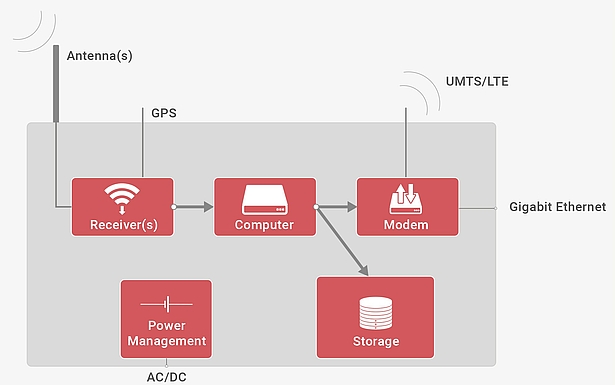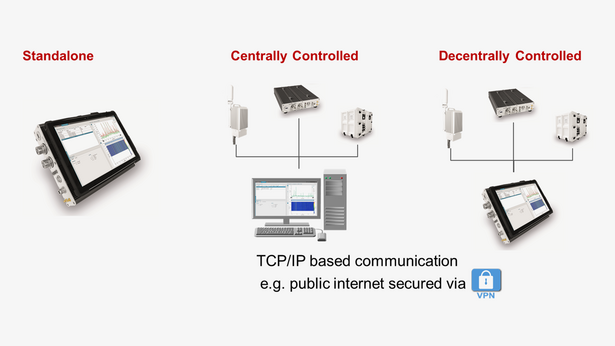Automated continuous spectrum monitoring & location system
The LS OBSERVER system offers a comprehensive portfolio of remote monitoring units (RMUs) which are controlled by the powerful central monitoring software (CMS). It is made for continuous monitoring of the entire RF spectrum of interest with a distributed sensor network or for standalone in-field measurements. With LS OBSERVER, your employees no longer have to keep an eye on the spectrum on a 24/7 basis, but can concentrate on concrete problems.
Once an anomaly is detected, the CMS software triggers an alarm and is able to determine the location of the signal source with three different technologies. With the unique automated continuous recording concept of LS OBSERVER, no information will be lost. The measurements of the entire frequency range of interest are permanently stored directly on the RMU. The recorded data can simply be filtered and downloaded from the devices for a subsequent analysis. With the unique DF Time Travel® and GROA+® method, emitter localization can even be done based on stored data. Besides detecting and locating anomalies, LS OBSERVER provides meaningful statistics of the spectrum usage over time in form of channel occupancy data. The RMUs are available in different form factors for different applications starting from fixed installations over (trans-)portable and handheld devices up to drone-based systems.
Remote Monitoring Units
RMUs
Central Monitoring Software
CMS
The Key Features of LS OBSERVER
Explore the Capabilities of Our Automated Spectrum Monitoring & Geolocation Solution
Each LS OBSERVER remote monitoring unit (RMU), whether if it is portable or fixed, includes the same major internal parts.
Did you know?
The internal storage of the RMU is sufficient to store up 4 weeks of raw data and up to 2 years of compressed data, depending on the receiver settings.
Depending on the required frequency range and application, different antenna and receiver options are available. The 318w version captures the widest total frequency range from 9 kHz up to 18 GHz. Further dual receiver options are available where the RMU is equipped with two completely independent working receivers for parallel tasking (e.g. direction finding and wide-band monitoring in parallel). With the powerful embedded computer, all data procession is done directly on the RMU without the need to transfer big data packets like IQ data to a remote operator. The RMU is able to autonomously run different tasks like a permanent comparison of the measured spectrum with a reference spectrum in order to detect interference, non-compliant or faulty emitters automatically. Each RMU has a large embedded storage to permanently record an ultra-wide frequency range. In comparison to recording on a remote server, this has the great advantage that you do not need a permanent network connection. Even if the connection is unstable or the data rate is low no measurements will be lost, everything is stored directly on the RMU for a later analysis. The operator can easily download exactly the data he needs from the RMU storage thanks to the comprehensive filter functionalities of the CMS software. While for traditional systems all measurements need to be performed live, LS OBSERVER offers multiple features to analyze stored data. With the unique DF Time Travel® feature, even direction finding and emitter localization can be done subsequently based on stored data. In addition, the RMU automatically calculates and stores a noise-free version of the raw data provided by the receiver. This compressed data format needs less storage space and gives the operator a fast overview of the signal scenario as well as SNR values. Based on this, a third data format is calculated by the RMU, the frequency channel occupancy (FCO) data. This data type provides a detailed overview of the occupancy over time for different channels, which can be used as the basis for spectrum policy decisions. The integrated modem in the RMU manages the network connection. The RMU can either be connected wired via Gigabit Ethernet to a network, or can be connected wireless via 3G/4G. The network communication is based on TCP/IP and thus many wired and wireless communication networks (e.g. the public internet secured via VPN) can be used. The RMUs can either be directly controlled locally with the CMS software or remotely via the network. The remote control can not only be done from a control center but also form one portable device. This allows an operator in the file to control other networked RMUs decentrally to e.g. triangulate an emitter.
Automation
LS OBSERVER takes over the 24/7 permanent monitoring for you. It monitors your entire frequency range of interest and automatically alarms you in case of anomalies. Parallel to this everything is continuously recorded and can be analyzed in detail later. Of course you can still perform monitoring live and control the units manually.
Usability
The LS OBSERVER CMS software stands for its user-friendliness and easy handling. The operation of the software is intuitive: The amount of buttons and input fields are reduced to a minimum, the views and menus are clearly arranged.
Storage concept
Each LS OBSERVER remote monitoring unit (RMU) includes its own large embedded storage space. The complete spectrum of interest or a part of it can be permanently recorded to the internal storage without having to transfer data to a remote server.
By this the RMU can be also operated stand-alone or in a network with unstable connection. The stored data can simply be downloaded from the unit remotely or by plugging in a laptop. With the LS OBSERVER CMS the user has multiple possibilities to filter the recorded data sets in order to download exactly the data he needs for his analysis.
Analysis on stored data
With LS OBSERVER, every measurement and analysis which can be done live can also be done based on stored data. With the unique DF Time Travel® and GROA+® feature even direction finding and emitter geolocation becomes possible on stored data. Was there interference during the night and where did it came from? You will never know with traditional monitoring systems, if you do not have a high number of employees available who take care of the monitoring 24/7. With LS OBSERVER you can simply analyze the recorded measurement the next morning in the office and locate the interfering signal source subsequently.
Transmitter database integration
To detect unknown emitters, interference or faulty transmitters it is essential that the monitoring system knows about the nominal condition of the wireless environment. This means the system knows all authorized transmitters i.e. their location, frequency, power and bandwidth. For a national regulatory authority this can be all transmitters from the spectrum management database, for an airport or industrial company all radio infrastructure on the corresponding premises and for the military all radio channels used by their own forces. Such a database of known or licensed transmitters can be connected to the LS OBSERVER CMS software or a transmitter list can be imported. The automatic violation (AVD) feature then permanently compares the measured spectrum with the theoretical spectrum and triggers an alarm in case of anomalies.
Unique features
LS OBSERVER offers a wide range of unique features. With the automatic violation detection (AVD), the measured spectrum is permanently compared with a transmitter database. Based on the distance to the transmitter the monitoring unit receives the signal with a different level. To set up a mask for each known transmitter individually for each monitoring unit means an enormous effort. With LS OBSERVER the included wave propagation feature calculates for each monitoring unit in the filed the individual expected receive levels at the location of the unit automatically. The wave propagation module is also used for GROA+® geolocation calculations where the power differences of an emission received at different locations is taken to locate the emission source. Without considering wave propagation as well as terrain and clutter data this method would be imprecise. The AOA 1xx DF antenna system offers several unique features like direction finding based on stored data with the DF Time Travel® technology as well as co-channel signal resolution with the multi-spot heatmap feature.
Permanent innovations
LS OBSERVER lives from its permanent innovations in software as well as hardware. New requirements from the market as well as individual suggestions from customers form the input for our agile development.
With its comprehensive hardware portfolio and various software add-ons LS OBSERVER addresses many different customer groups. Depending on your requirements and use-cases we find the perfect LS OBSERVER hardware and software set-up for you. Our customer groups are structured as follows:
| 3rd party equipment integration | AI-based anomaly detection & classification | Automated workflows |
| Automatic Violation Detection (AVD) | Channel power analysis | Channel templates & analysis |
| Cockpit with one-click actions | Correlation with Spectrum Management | Demodulation |
| DF Time Travel® | Direction finding (DF) | Export in open formats |
| Fixed frequency mode | Frequency channel occupancy (FCO) | Frequency list mode |
| Frequency plan overlay | Geolocation | Heatmap |
| Homing | Hybrid TDOA/AOA | ITU compliant signal parameter measurements |
| Map visualization | Measurement chart | Measurement jobs |
| Measurement templates | Network management | Recording (Raw, IQ, Statistics) |
| Remote control | Reporting | Rights management |
| Scan mode | Time difference of arrival (TDoA) | Waterfall display |
The rapid expansion of Non-Terrestrial Networks (NTN), especially through the deployment of non-geostationary (NGSO) satellite constellations like Starlink, has created a growing need for effective spectrum monitoring.
Regulatory authorities, military agencies, and other stakeholders require reliable tools to observe and analyze satellite transmissions. This is critical for detecting potential interference with terrestrial services, geostationary satellite (GSO) ground stations, and to verify that spectrum usage complies with national rules and regulations.
LS OBSERVER addresses these needs with mobile and semi-fixed satellite monitoring systems, complemented by a comprehensive suite of software features for in-depth signal analysis. Our solutions are capable of tracking satellite transmissions and identifying unauthorized or interfering signals across relevant frequency bands.
Devices such as the LS OBSERVER PPU can be integrated with phased-array antenna modules to enable dynamic satellite tracking and real-time monitoring of emissions. The LS OBSERVER CMS software interfaces with Two-Line Element (TLE) data to precisely predict satellite orbits and control the electronic beam steering of the antenna system accordingly.
Users can configure the LS OBSERVER to track individual satellites or perform full-sky inventory scans. The system records all detected emissions, correlates them with a database of known satellites, and flags unidentified signals for further investigation - empowering users with full situational awareness and actionable intelligence in the evolving NTN landscape.
With the expansion of Non-Geostationary Satellite Orbit (NGSO) constellations, there is increasing interest from regulatory bodies, security organizations, and military agencies in identifying whether Non-Terrestrial Network (NTN) services are being used in specific areas.
User terminals connecting to NGSO satellites transmit highly directional, narrow-beam uplinks, which are difficult to detect using conventional ground-based monitoring solutions. These beams are tightly aligned with the satellite’s trajectory and can't usually be measured unless they are intercepted at the right angle and altitude.
The LS OBSERVER Airborne Monitoring Unit (AMU) is a fully drone-integrated spectrum monitoring system designed to address this challenge. By flying through the main beam or side lobes of the satellite uplink, the AMU can detect and capture transmissions that would otherwise go unnoticed.
Before any localization takes place, it is essential to determine whether such signals are present at all. The AMU enables this initial detection over wide areas, helping operators confirm the presence of NTN usage.
Once signals are detected, the AMU’s airborne drive test capability can be used to measure and visualize signal strength across multiple flight paths. This data is then analyzed to estimate the approximate location of the transmitting ground terminal.
This airborne monitoring approach adds a valuable dimension to spectrum monitoring - offering mobility, flexibility, and effective coverage for identifying and assessing satellite-based uplink activity.
















